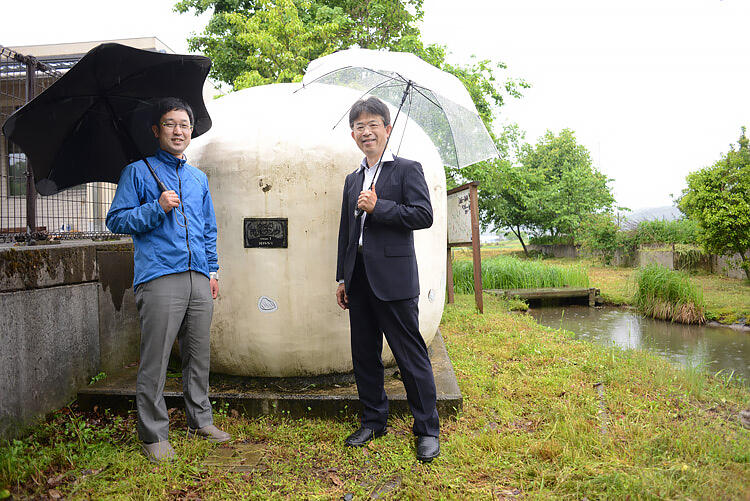
Japan experiences extensive rainfall, but by dealing with rainwater in a more effective manner, steps can be made to solve many problems facing society, such as flooding or drought. The Shimaame Lab, founded by Professor Toshihiro Kasai and Associate Professor Sho Kondo of the Faculty of Environmental and Information Sciences at Fukui University of Technology, is working to demonstrate this through research and educational activities in their drive to build a society in which it is normal to utilize rainwater. This article introduces the lab and their activities on Akashima Island, part of the Goto Islands in Nagasaki Prefecture.
Controlling water levels in rivers while providing water during drought
There has been noticeable damage caused in Japan in recent years due to flooding as a result of typhoons and torrential rains. For example, the Asuwa River in Fukui City burst its banks and flooded the city during the local torrential rains in 2004. Residential areas were engulfed by mud flows, with more than 3,200 houses flooded above floor level and 8,000 houses flooded below floor level, making flood countermeasures an urgent necessity.
In fact, the need for measures against short-lived torrential rains on the one hand, and to secure a stable water supply during droughts on the other, is an urgent issue faced by Japan overall, not just specific regions.
One flood control measure is to store rainwater in underground tanks, limit the amount of rainwater that flows into the sewers and rivers during torrential rains, and release it slowly later. Such a rainwater storage system has actually been developed through joint research between Professor Kasai and Chichibu Chemical (Chiyoda City, Tokyo), commercialized, and is currently being utilized overseas.
What is needed next is to utilize that rainwater. With a system for storing rainwater, it is possible to control the water level of rivers during heavy rains, while also providing water during drought. The stored rainwater can also be used for purposes such as toilets when infrastructure is disrupted due to major earthquakes and other disasters. And if a water purification system is added to the storage, the rainwater can even be used to drink or cook.
"Research progress has been made regarding water quality," notes Professor Kasai, who explains, "Rainwater is full of many impurities when it first begins to fall, but the rainwater that falls later is actually very clean, almost as clean as distilled water. This is why the air feels cleaner after the rain." Meanwhile, rainwater is quite soft, containing only one twentieth of the calcium and magnesium of Tokyo tap water, making it excellent for use in cleaning or car washing compared to tap water because it does not leave residue.
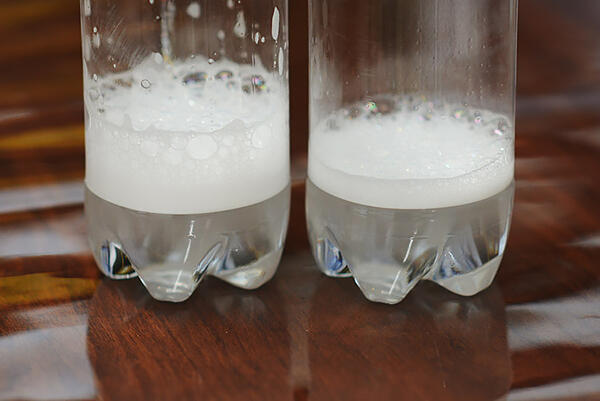
Though the amount of rainwater used in Japan annually is rising year by year, it was still only approximately 124 million cubic meters as of 2020, and use is primarily limited to toilets and water sprinklers. In comparison, the total amount of water collected per year from water sources, such as rivers and groundwater, is nearly 80 billion cubic meters. In other words, the amount of rainwater used is less than one six-thousandth that of regular water. The Shimaame Lab, led by Professor Kasai, is working to change this.
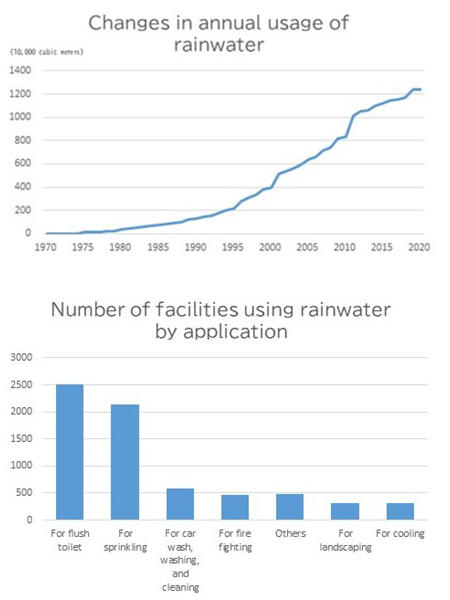
Project on Akashima Island, an island without running water
Professor Kasai had long searched for a village that was still using only rainwater for daily life in order to carry out research that matched actual conditions in the field. As a result of his search, he found Akashima Island, part of the Goto Islands in Nagasaki Prefecture. Because the island has no water supply system, several of the islanders (seven people as of 2022) use rainwater that they store in tanks.
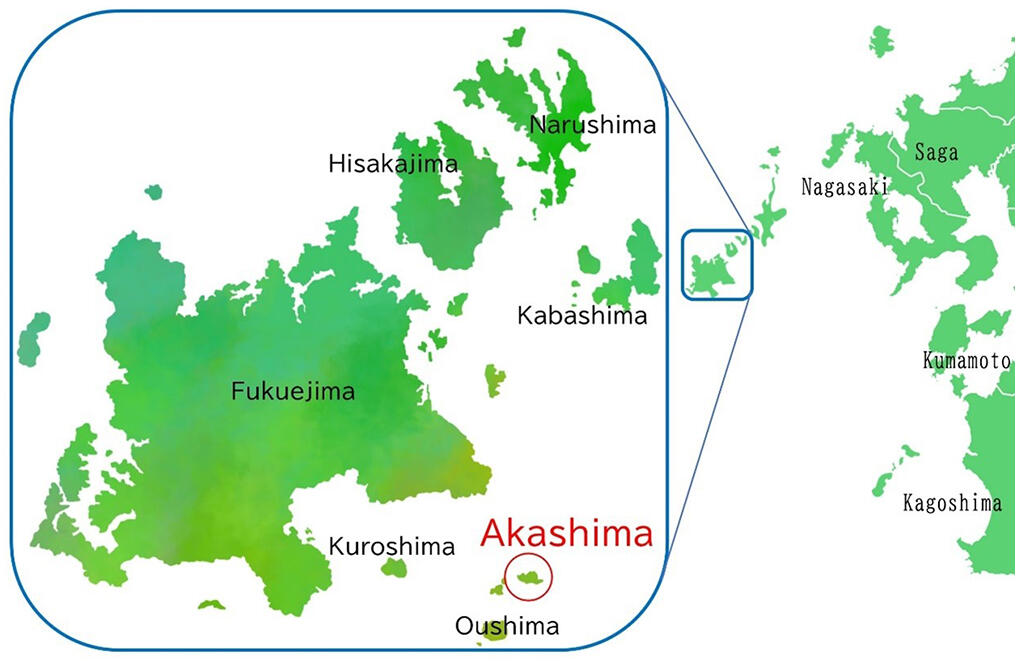
(Provided by Shimaame Lab and translated by JST).
Professor Kasai visited the island for the first time in 2016. He looks back on that visit, explaining, "The people of Akashima Island had a completely different perception of water from the rest of us, because every day they are faced with the constant risk of running out of it." A survey demonstrated that the people of Akashima Island only use about 60 liters of water per person per day, or less than 30% of the amount used by Tokyo residents (roughly 210 liters). Having thus understood the situation faced by the islanders, who were nervous not only about water supply but quality as well, Professor Kasai established the Shimaame Lab together with research partner Associate Professor Kondo in order to build a water supply system using rainwater that could be used safely.
The following year, Professor Kasai, accompanied by students of the lab, visited the island to build a "rain field" on elevated ground some distance from the village. This location was chosen to avoid salt from seawater from being mixed with the rainwater. The rain field was completed after about three weeks of labor under the scorching sun, resulting in an area of approximately 50 square meters. While the team was unable to go on to complete the water supply facilities that year, they visited again the following year and the year after that, improving the system each time, finally completing a system to supply water to the island's inn, Akashima-no-ie (Akashima House).
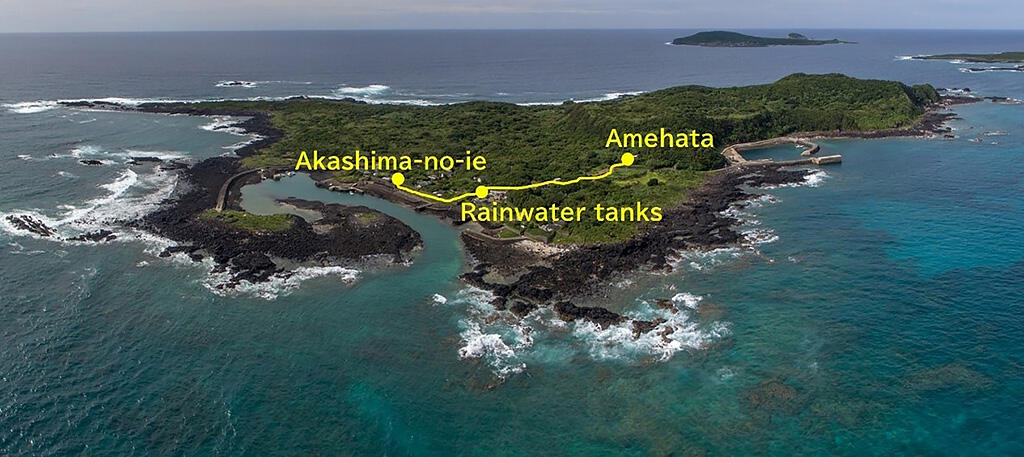
The system includes equipment that removes the poor-quality initial rainwater, and it can be monitored remotely via the Internet. Professor Kasai is looking ahead, believing that the data and knowhow obtained on Akashima Island can be applied to other regions in Japan and throughout the world helping to greatly improve the lives of people suffering from inadequate water supply. The Akashima Island Project won an award for excellence under the STI for SDGs awards program in 2020 in recognition of its applicability to other remote islands.
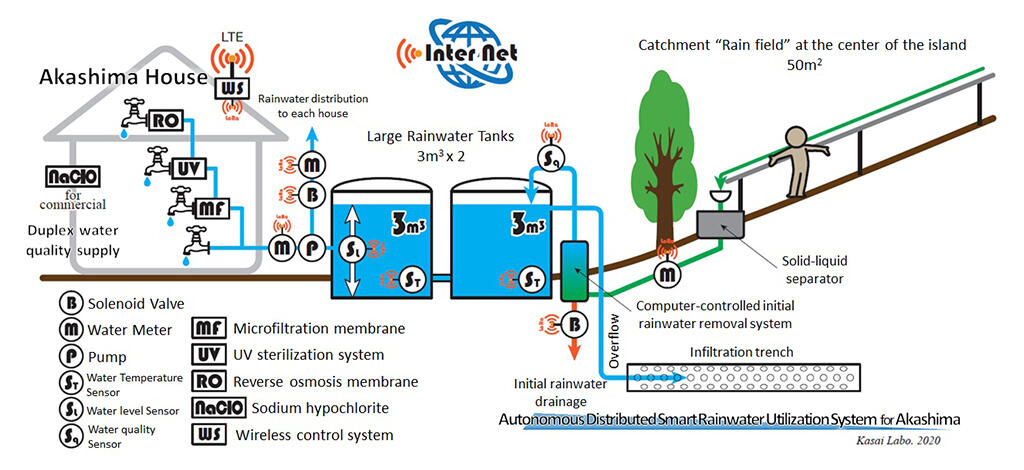
(Provided by Shimaame Lab and translated by JST)
Meanwhile, the water-conserving toilets installed on Akashima Island, capable of using less water for flushing even when water supply is interrupted during disasters, have been commercialized by LIXIL Corporation under the product name of Resilience Toilet. Professor Kasai explains that the collaboration involving the toilet is necessary for improving the sanitation of toilets on Akashima Island because of the value of water there and the lack of a sewage system. This initiative was further recognized via the Grand Prize of the Japan Resilience Awards 2021 for contributing to the building of the next-generation resilient society.
Rainwater tanks that can be used in any home
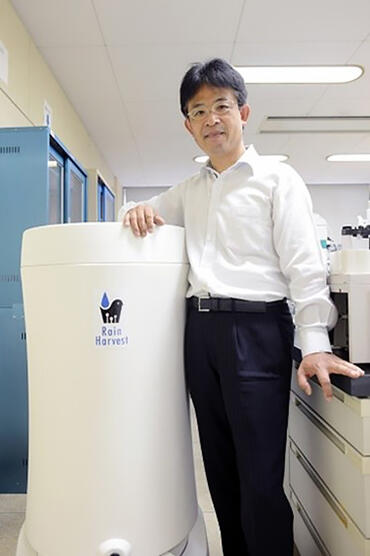
The activities of Professor Kasai and his team are not limited to Akashima Island. For example, the team has developed a home-use rainwater tank called Rain Harvest in collaboration with a local company to enable the easy use of rainwater in any home. The water inside the tank is replaced each time it rains, and a system is included to eject the debris that accumulates at the bottom. It requires no maintenance, and it is the first rainwater tank in the world that allows the use of quality water in the event of an emergency, such as a disaster.
Meanwhile, Professor Kasai and his team are also considering the creation of a cloud-based rainwater tank system. Connecting multiple rainwater tanks via IoT devices and enabling consolidated monitoring of rainwater volume will show where water can be obtained in the event of water supply disruption during disasters. Meanwhile, when a large amount of rainfall is predicted, the old water can be drained via the cloud system beforehand. The subsequent storage of new water will help alleviate flooding while providing a source of clean water.
Professor Kasai explains, "I believe my role as a researcher is to communicate the benefits of utilizing rainwater and getting people from a variety of domains involved."
Rainwater cider to quench your thirst
Professor Kasai is also working to spread awareness about rainwater harvesting. In 2018 and 2019, he hosted a tour for children between elementary and high school age to experience life using rainwater on Akashima Island. The tour proved very popular with the children, and gave them a sense of the value of water through the experience of living without a water supply system.
Furthermore, in 2021, he created a drink made with rainwater in collaboration with a beverage manufacturer located in Fukui City. The product achieved the quality level required for sale, clearing all water quality criteria listed in relevant food sanitation laws.
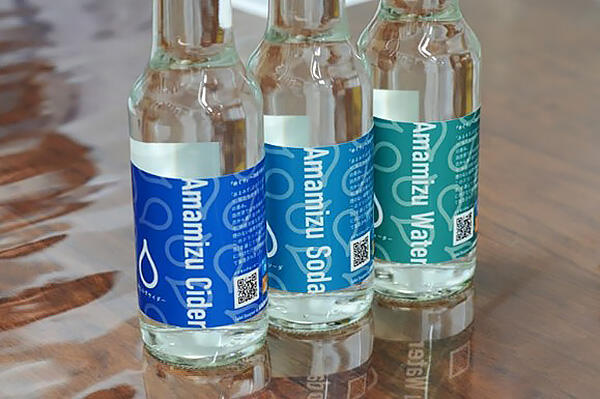
Package design by Associate Professor Kondo. (Japanese cider refers to a carbonated soft drink, not alcohol)
Associate Professor Kondo was in charge of coming up with a package design that would entice people to try the drink. At first, Associate Professor Kondo was skeptical about the benefits of rainwater harvesting, but he was moved by Professor Kasai's enthusiasm and became a uniquely valuable partner through the process of assisting in the Akashima Island project.
It starts by changing people' attitudes
Professor Kasai explains, "Everyone used rainwater before we had water supply systems. But somewhere along the way, we forgot all about that. Now we just assume that water has to come from the tap, but if you think about it, you realize that tap water originally came from rainwater anyway." Professor Kasai sees this lack of awareness as the most serious problem.
Even rainwater that includes the initial contaminated water can still be used in gardening or for flushing toilets with no problems at all. But today, the water we use for those purposes is processed to be just as clean as drinking water. A third of our water use is used by toilets every day, or roughly the same amount as used by the residents of Akashima Island each day, resulting in a great deal of waste.
Professor Kasai stresses, "We must fundamentally change the awareness of the Japanese people to achieve our SDG goals, and the same is true for water." Through the medium of water, Professor Kasai and Associate Professor Kondo will continue to speak out for a sustainable society.
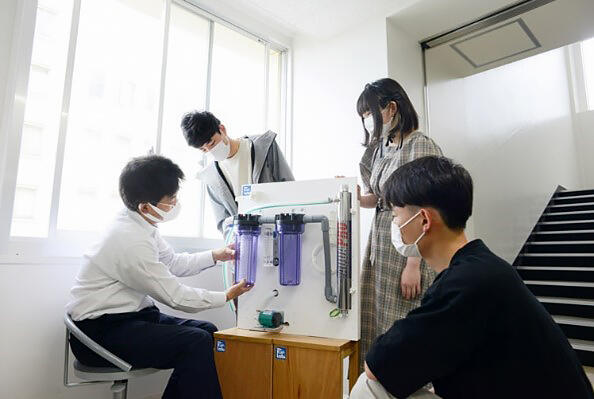
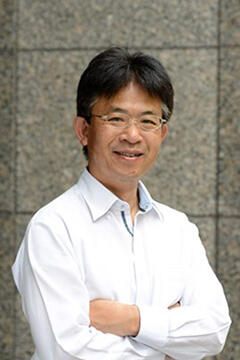
KASAI Toshihiro
Professor, Department of Applied Chemistry and Food Science, Faculty of Environmental and Information Sciences, Fukui University of Technology
Completed Doctoral Course in Materials Science and Engineering at Yamaguchi University in 1995. After working as a Research Assistant, and a Lecturer in the Faculty of Engineering, Nippon Bunri University, he became a Lecturer in Applied Science and Engineering, and an Associate Professor in the Department of Management and Information Sciences, Faculty of Engineering, Fukui University of Technology, and has been in his current position since 2015. He has been researching rainwater harvesting for more than a decade and promoting its use.
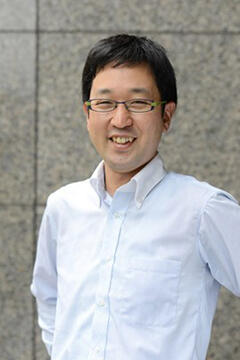
KONDO Sho
Associate Professor, Department of Design, Faculty of Environmental and Information Sciences, Fukui University of Technology
Completed a Master's Degree in Architecture and Design at Kyoto Institute of Technology in 2007. After working for a private company, then as an Assistant Professor and Lecturer in the Department of Design, Faculty of Environmental and Information Sciences, Fukui University of Technology, he has been in his current position since 2015. Launched "Shimaame Lab" with Professor Kasai, aiming to promote the use of rainwater with the power of design.
Original article was provided by the Science Portal and has been translated by Science Japan.




